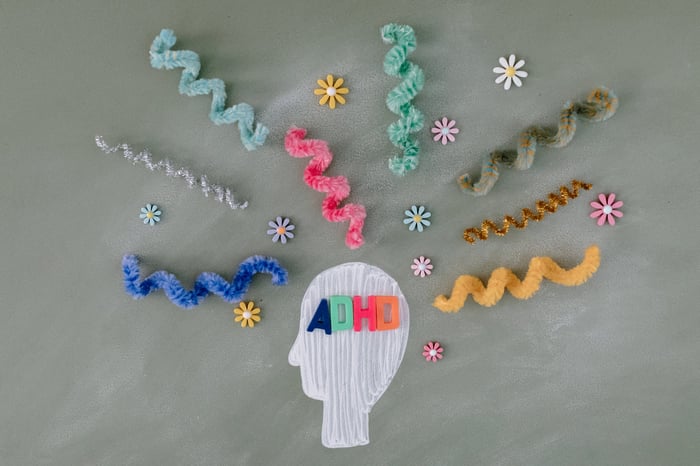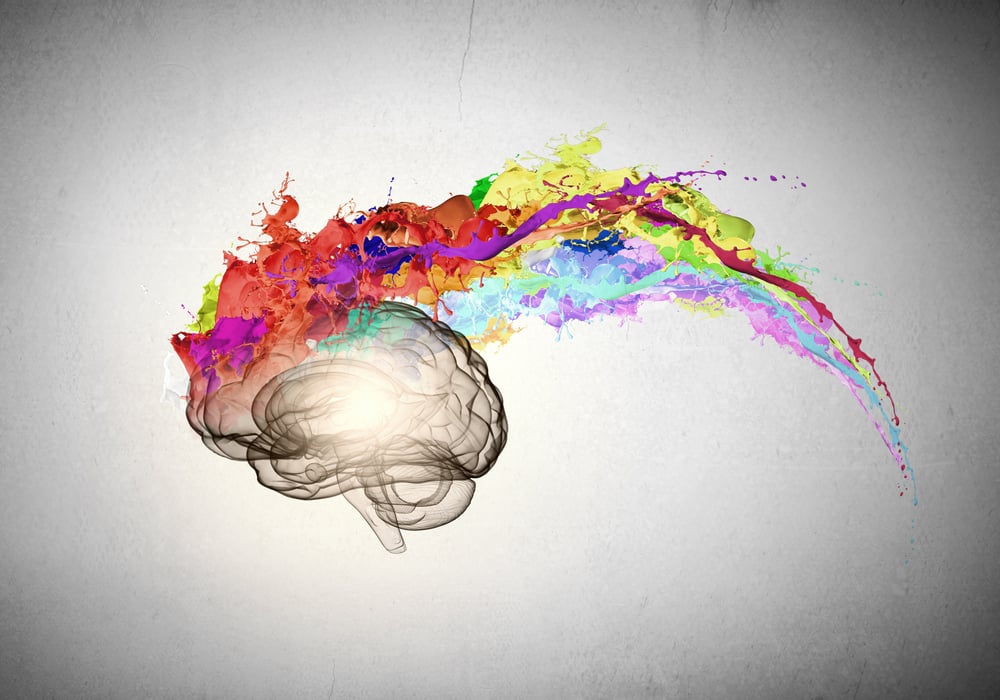ADHD receives a lot of press for the challenges and difficulties associated with the condition, but the positive side is almost entirely neglected. Professionals with ADHD offer a vast variety of strengths, skills, knowledge and experience to any workforce, ideally positioning them to drive creativity and innovation as well as an array of business-critical benefits.
This ADHD Awareness Month, Templeton’s recruitment specialists (20% neurodiverse ourselves) reveal how employers and managers can get the best out of their employees with ADHD.

What is ADHD?
Although ADHD stands for Attention Deficit Hyperactivity Disorder, there are in fact many different types, which are all experienced individually by each person with ADHD. The condition falls into the category of neurodivergence (as opposed to neurotypicality) including:
- Autism / Autism Spectrum Disorder (ASD) – Affects social communication and interaction with others, involves repetitive behaviours and sensory sensitivities
- Dyscalculia – Affects interpreting numbers and mathematics
- Dyslexia – Affects reading, writing and spelling
- Dyspraxia – Affects movement and physical co-ordination such as balance, exercise and driving.
Neurodivergent individuals experience the world in a different way to neurotypicals, which can translate to different thought patterns, feelings, preferences, reactions to events, needs, challenges and strengths. Whilst 1 in 7 people are estimated to be neurodivergent in some way, as many as 1 in 20 people are estimated to have ADHD. The condition is characterised with the following signs and symptoms:
- Shorter attention span, difficulty concentrating
- Difficulty of organisation and time management
- Forgetting things
- Being easily distracted
- Procrastination, moving from thought to thought and task to task
- Excessive impulse to talk and move around
- Difficulty interpreting and carrying out instructions.
ADHD can have a significant impact on the lives of individuals, causing difficulties with school and work, social interaction and achievement of personal and professional goals.

Myths About ADHD
Although the condition is widespread and believed to impact millions of people in every country around the world, understanding of ADHD remains low and confused. Some of the main myths surrounding the condition as based in:
- Intelligence – Any type of neurodiversity does not correlate with being clever, meaning that individuals with ADHD are just as likely to be highly intelligent as neurotypical individuals. Stereotypical, historic and popular methods of measuring intelligence are less well equipped to test those with ADHD, meaning assessments of intellect are often inaccurate and don’t take into account emotional and social intelligence.
- Hyperactivity – The ‘H’ in the term doesn’t have to mean bouncing off the walls and unable to sit still or sleep (although some individuals do experience sleep problems) but can also be closer to impulsivity or inattention.
- Control – Individuals cannot simply ‘control’ or ‘grow out of’ their condition, although adults often develop better coping mechanisms to limit negative impact to their daily working life and own mental health. Like other neurodiversity types, there is no ‘cure’ for ADHD, however the right support and resources can help individuals better reduce stress, meet their own needs and achieve tasks and goals.
- Motivation – ADHD is not a result of a lack of motivation or laziness: both adults and children with the condition often expend much more effort than neurotypical classmates and colleagues, but face far more difficulty in interpreting instructions and completing tasks. Problems with focus are not due to attitude or deficiencies in personal qualities, but due to differences in the way the brain is structured and how it functions.
- Bias – Like attitudes towards autism, ADHD is often wrongly assumed to only affect young male children. Boys are more than twice as likely as girls to be diagnosed, however this is more of a reflection on historic gender bias in the medical field, and on behalf of parents, teachers and carers who do not associate symptoms with female children and are less likely to refer them for assessment. Girls and women with ADHD are increasingly gaining new diagnoses or self-diagnosing after years and often lifetimes of struggling, in an effort to gain the understanding and support they have lacked and can now benefit from.

The Challenges Faced in the Workplace by Employees with ADHD
Just like any other person, every individual with ADHD is different, and will experience different challenges and needs. Many people with ADHD experience some or all of the following challenges in the workplace:
- Prioritisation – The condition is often associated with ‘racing thoughts’, feeling like the brain is ‘busy’ and moving around from thought to thought, and accompanied by high levels of anxiety, which worsen during periods of stress or increased responsibility. Anxiety about completing multiple projects or tasks simultaneously can make focus more difficult in general, meaning that employees can fall into a pattern of working mostly on tasks that are easier to concentrate on, instead of which are most urgent or have closer looming deadlines.
- Organisation – The ability to prioritise effectively is strongly linked to organisation: a lack of order means important tasks can slip through the cracks, being forgotten completely for an extended period of time and further delaying or impacting on other projects and people. Challenges with planning can lead to underestimating the time needed to complete tasks or incorrectly matching tasks and projects with the dedicated time and energy they require.
- Time-Keeping – Regardless of effort and trying different strategies, a person with ADHD can find it more difficult to manage their own time, resulting in lateness to meetings, delays to deadlines and frequently turning up to offices and worksites officially late for work. Poor memory can further impact on timekeeping, in some cases reducing productivity and increasing work-related absences for a multitude of reasons.
- Mental Processing – Whereas some thought processes can be faster and more intuitive than for neurotypical people, neurodivergence means the brain thinks in a completely different way to those of other colleagues. Employees with ADHD may struggle in meetings and when presented in-person with new ideas and changes, needing time to properly digest information and formulate the best response and action plan, sometimes days after important meetings and presentations.
- Attention to Detail – ADHD can make focus more intense when involving tasks that are personally interesting or meaningful to an individual, but regarding other tasks the opposite can be true: attention is much harder to hold without interest, reward or reasons for strict time discipline. With even quiet noises, small environmental changes or sudden thoughts providing very frequent distractions, fine details can easily be missed, and more complex data and processes can be tricker to manage. Mistakes can be common and impactful, despite the best efforts of the employee.
- Impulsivity – The hyperactivity element of ADHD can promote impulsive behaviours, meaning an individual agrees or commits to something that at the time sounds exciting, interesting or helpful, before later being confronted with the reality that the task cannot be completed within the timeframe, resource limitations or skill/knowledge deficits. Impulsive comments and decisions can also have consequences for colleague relationships and project success.
- Relationships – Misunderstanding or total absence of knowledge of a colleague’s ADHD can cause a rift between co-workers. Team members and managers may feel unable to rely on an individual if they are perceived to have a track record of missing deadlines or forgetting to include colleagues in important updates, and may feel they need to ‘rescue’ tasks or projects at the last minute if their colleagues have not met deadlines. Employees with ADHD can find it harder to widen their professional network, build relationships in the workplace and receive support and training from their colleagues and managers, with each in turn having their own impact upon the individual’s work performance, career growth and mental health.

Strengths of ADHD in the Workplace
- Hyperfocus
Whilst individuals with the condition experience problems with a lack of focus in many areas of life and work, the opposite can be true with topics and projects that someone with ADHD is especially interested in and passionate about. The term ‘hyperfocus’ is similar to a ‘state of flow’ where the worker is completely absorbed in their activity, except neurodivergent individuals experience this more intensely and for longer periods of time, to the exclusion of other activities such as forgetting to eat or drink. Employees with ADHD often experience hyperfocus on large intricate projects such as coding and software development, as well as design and creative tasks. Hyperfocus periods see employees operate at a much higher level of efficiency and effectiveness, often producing work in hours that would have taken others several days to produce, and coming up with ideas and improvements that are completely unique.
- Creativity
Neurodiversity naturally empowers ‘out-of-the-box’ thinking: people with ADHD experience the world in a very different way to neurotypical colleagues and bring a wealth of knowledge and ideas. Individuals make connections more easily and can imagine problems from different perspectives for a truly unique way of thinking. Cognitive diversity means unique and often underutilised perspectives that can help with creative thinking and new approaches when challenges and opportunities arise. With every neurodivergent person working in a group, that group becomes more diverse and better equipped to innovate and solve problems. Harvard Business Review report that diverse groups of people, especially those that are cognitively diverse, are much better at solving problems than within teams in which there are only cognitively similar people.
With 1 in 7 people in the global population thought to be neurodivergent in some way, neurodivergent customers and customers with ADHD present vast consumer bases of millions in every country all over the world. Diverse consumer groups are historically under-supported and undervalued, with large purchasing power ready to be addressed by companies that truly understand and can cater to their needs. This is even more true of neurodivergent customer bases, who as an ‘invisible’ diverse group have long been left out of Diversity & Inclusion initiatives. With their first-hand experience of living with ADHD and their different ways of viewing the world, employees with ADHD can better anticipate, understand and design for the needs of neurodivergent customers, helping to grow customer satisfaction, consumer loyalty and ultimately business revenue.
Where others see chaos, those with ADHD see opportunity. These creative powers can translate into a determination to solve difficult problems and come up with ideas that go far beyond the realms of company standards to drive true innovation. Neurodivergent employees are constantly learning and striving to improve their own skills and the success of everything they do, which includes supporting their colleagues and helping employers achieve company goals.
- Energy
Often described as ‘relentless’ and known for their hyperactivity, individuals can display an energy and enthusiasm for work even when others feel tired, burned out or lacking in motivation. High energy levels help them and encourage others to push through difficult project stages and periods of change, and when harnessed properly can reach new levels of productivity and effectiveness.
Employees with ADHD often make excellent managers because they genuinely love and are gifted at motivating others, exciting team members and bringing them along with new projects and major change. Their positive influence is infectious, lifting the mood of a group and uniting colleagues for better team spirit and collaboration.
- Flexibility
Impulsivity enables spontaneity and flexibility: a character that can pull ideas from nowhere, can follow and get on board with new ideas and suggestions, and with the right support can more quickly and easily adapt to – and thrive in – unfamiliar situations than neurotypical colleagues. Fast thinkers are strong in a crisis, responding intuitively and innovatively to emergencies and acting effectively whilst keeping the best interests of everyone involved at the forefront of their response.
- Courage
Adventurous and brave, employees with ADHD can offer all the benefits of an entrepreneurial style whilst collaborating well within a team. A unique way of seeing the world means less fear of taking strategic risks and trying new things, with an optimism for positive outcomes and the drive to lead a revolutionary vision. Individuals can lead unprecedented changes to systems, ways of working and the very core of companies themselves, focusing more on the benefits of positive change than the limitations or corporate politics behind them, and serving as true leaders who achieve the never-before-possible.

How to Manage and Support an Employee with ADHD
- Listen
What benefits one neurodivergent individual may be very different for another neurodivergent individual: the best thing a manager can do is listen. Active listening means not only asking for opinions and feedback, but also making an employee feel genuinely valued and supported, that their voice is heard, and that they are empowered to create positive change. The most effective managers will personalise their approach to each direct report by proactively and regularly seeking to discover what employees experience challenges with, what their wants and needs are, and how they can be best supported. Questions should include:
- What do you enjoy most and least about your job, and why?
- Are you currently struggling with anything or finding anything particularly challenging?
- Do you have in mind anything specific that I can put in place to help you, or would you like me to come up with ideas for adjustments?
- Do you have the equipment, training and skills you need to do your job, and if not, where are the gaps?
- What would make your job less stressful/more enjoyable?
- What do you most want to achieve in the next year and further ahead – what are your career goals and what would you need to do/have/get to achieve them?
Particularly if the individual has only recently been diagnosed, they may not have much knowledge of what specifically will be helpful to them. Managers who personalise their approach to their employees will have the best grasp of what motivates and helps each individual, and will be able to make suggestions that are most likely to address their specific problems and needs.
- Provide Accommodations & Adjustments
The UK Equality Act of 2010 legally binds employers to make ‘reasonable adjustments’ for employees with disabilities, under which umbrella ADHD and other neurodivergent types can be recognised. Listening to employee challenges and needs can make it clear exactly which adjustments will help and in which way, including but not limited to:
- Quieter Work Areas – Aiding focus without distractions from noise and other people
- Flexibility – Flexible start times with more emphasis on output and quality instead of volume of hours worked; ability to work around therapy appointments to promote mental health; adding in more frequent breaks to better manage energy
- Hybrid Working – Remote options to help individuals set up and work in the environments that are most comfortable for each person and most conducive to their productivity and problem-solving style
- Headphones – Cancelling out distracting noise or bringing in music/podcasts that aid creative flow
- Time – More time to respond to questions and give feedback can offer the space to check up on details or facts before voicing an opinion or suggestion, rather than providing a less than satisfactory or wrong answer under stress
- Training – Translating training materials into different formats, such as video for individuals who have better visual focus and active workshops for individuals who learn and remember through practical activity.
Most adjustments to working environments are completely free or very low-cost but the benefits they bring for employee productivity, engagement and retention are monumental. Not every adjustment will work for every individual, but the right adjustments will make a world of difference, and help managers ensure employees are as effective and fulfilled as possible.
- Communicate Clear Deadlines & Agreements
Good delegation is an important part of any managerial role, but so often overlooked. Employees need to truly understand not only what they’re doing but also how and why, to ensure the task is completed to the exact standards and timelines required, and that employees are consistently working towards wider team and company goals. Delegation is often rushed, with employees expected to ‘pick things up as they go along’ due to time pressures. However, neurodivergent and neurotypical employees will all deliver more value in both the short and long-term, and remove far more time and task burdens from their managers, with more initial investment in communication and training.
The best managers will set clear agreements and deliverables for all their direct reports, and provide additional explanation to their employees with ADHD, by:
- Describing What Needs to be Done – Setting out what the task is and what expectations are (for example: a full analysis of the new business revenue data from Q2 and Q3 2023, presented in an Excel and PDF report that includes graphs showing progress against the four previous quarters and at least three recommendation points based on insights)
- Clarifying the Purpose – Revealing exactly why the task is important and what it will be used for (for example: the report will be viewed and discussed by the management team on Monday 16th, and management will use the insights to make a future plan of action in these specific areas)
- Anticipating Challenges – Discussing any problems the manager can foresee given their knowledge of the employee, the task and the company processes, ahead of time, and offering the support that can be given (for example: the data team do not currently have the Q3 data but will need to get this to you before the end of this week to give you enough time to create the report, so please email them asking for this)
- Giving a Deadline – Asking politely for the task to be completed by this date and time, and delivered in this way (for example: emailed to me by Monday 16th at 2pm, ahead of the management meeting to discuss the findings of the report).
Where there is no set deadline for a task, many individuals with ADHD will find it helpful to be set ‘fake deadlines’: they agree to deliver a task into their manager’s inbox by a certain date and time, helping them prioritise similar tasks and avoid forgetting less timely tasks until they become an urgent problem.
Asking the employee to repeat instructions back in their own words helps managers check the employee’s understanding of the task, and provides the opportunity to further clarify anything that has been missed before the employee starts to work on the task.
- Organisation – Tools & Processes
The process itself is less important than the agreement: keeping to one way of doing something, delivering it and reporting on it will all help maintain consistent quality of tasks and prevent employees from expending time and energy on unnecessary ways of working. Processes enable managers to keep their teams accountable and develop skills in time-management and organising their own workload.
Post-it notes and paper diaries can help recall and prevent details from being lost in the short-term, but long-term organisation requires one system containing tasks and projects plus all information and communication associated. Project management tools help to:
- Plan and schedule workloads to prioritise tasks and projects
- Keep all information in one place to easily access data and check back on decisions and requirements
- Send automated emails and alerts to remind individuals to complete tasks
- Communicate information and instructions between team members
- Stay on track to budget, times and goals without distraction or deviation.
- Written Instructions
Verbal instructions can easily be misunderstood or forgotten, especially during times of stress or when communicated alongside several other directions, and which is especially true of employees with ADHD. Communicating on paper (or screen) forces a manager to explain clearly, in brief to focus on the most important elements of the task, and think about how the employee will understand and interpret the instructions. Writing down instructions helps employees pay attention to important details and feel empowered to complete the task independently, reducing the need for managers to repeat conversations and reducing employee errors.
Checklists can help individuals to manage their own time and remember to complete daily, weekly and monthly tasks well in advance, as well as keeping track of exactly where they are in regular processes and what actions need to be taken next.
- Harness Hyperfocus
Individuals with ADHD can initially show much enthusiasm for tasks and projects, but sooner or later become bored, unchallenged and unmotivated. Some employees will require a variety of different things to do every day to keep them engaged, whereas others will want days or weeks set aside to deep-dive into one particular activity that they love.
Hyperfocus can be harnessed by managers who pay close attention to what most engages, interests, excites, motivates and fulfils their direct reports. Managers can employ various tactics to access hyperfocus in a positive way whilst ensuring employees do not become burned out or work too hard in one area. Tactics include:
- Continuous Discovery – After every period of hyperfocus take note of what specifically engaged the employee and made them so effective at the task, and ask them why they felt so motivated and excited to complete the task, to provide similar tasks in future and replicate the positive experience.
- Regular Reward – Individuals are all motivated by different things, but if these can be tapped into, they can provide extra momentum to complete even the most arduous of tasks. If an employee believes in and looks forward to a reward upon completing a task or project – for example moving on to a more exciting project straight afterward, taking a longer break, going to lunch with their colleagues or winning a place on a competition leaderboard for a prize – they will find more external motivation to help them complete the task.
- Gamification – Proven to hold attention and maximise engagement, gamifying a task involves influencing and creating specific behaviours from the players, motivating players to achieve the desired outcome. Game principles include clear rules to maintain focus, competition (against a clock, high standards or someone else), transparency of progress, and a real sense of achievement or ‘winning’ at the end and at key stages throughout the task. Players receive feedback along the way to learn and improve, enhance planning and strategy skills, and are empowered to make their own decisions and independently succeed.
- Task Management – Dividing tasks into sections and distributing to team members according to their strengths and interests will engage neurodivergent and neurotypical coworkers alike. Mixing up task type, duration and effort required, and helping your employees plan their energy and time invested according to the type, duration and effort required, will balance workloads and their impact upon your team, maximising opportunities for everyone to work on what they are most enthused by and most want to learn.
- Regular Communication
Keeping employees engaged will require regular checking-in to see how they’re feeling, where they’re excelling and motivated to keep learning and improving, and where they need support and closer management. Some of the accommodations put in place in the beginning may not serve an employee months of years later as the business changes and their career trajectory advances. Regular 1-2-1 meetings, ideally weekly or at least fortnightly, provide every employee with a safe space where they can share confidential worries and ideas with their manager without fear of judgment or recrimination. Managers can utilise 1-2-1s to gage what employees will need in terms of training, support and further adjustments, planning changes to ways of working and additional adjustments alongside employees to involve them and empower them in their own working life and career.
The challenges of ADHD can negatively impact the mental health and personal wellbeing of individuals at different stages of their careers and lives. As people bring their whole selves to work, personal problems can quickly become professional problems if left unvoiced and unsupported. The best managers know their direct reports well and build relationships based on trust and respect, empowering employees to proactively come forward with struggles and requests for help early on, enabling managers to support as soon as possible.
Hire & Harness the Benefits of Neurodiverse Teams
A recruitment agency created and staffed by neurodivergent recruiters who understand the power of neurodiversity will be far more effective at engaging neurodivergent talent. Built on the principle of diversity and inclusion in 1996, Templeton are an 85% diverse, majority-female team of specialist tech recruiters; 1 in 5 of us are neurodivergent, compared to 1 in 7 of the general population. Our team have first-hand knowledge and understanding of candidates with ADHD, their needs and challenges, and how employers can harness their skills and experience.
Read more about how we help employers recruit neurodivergent and diverse talent.
Discover the Benefits of Autistic Workers and How to Recruit Autistic Employees.




